The A16 Bionic, which was originally featured in the iPhone 14 Pro and Pro Max, is making its way into the new iPhone 15 and 15 Plus models, providing enhanced processing power for all users.
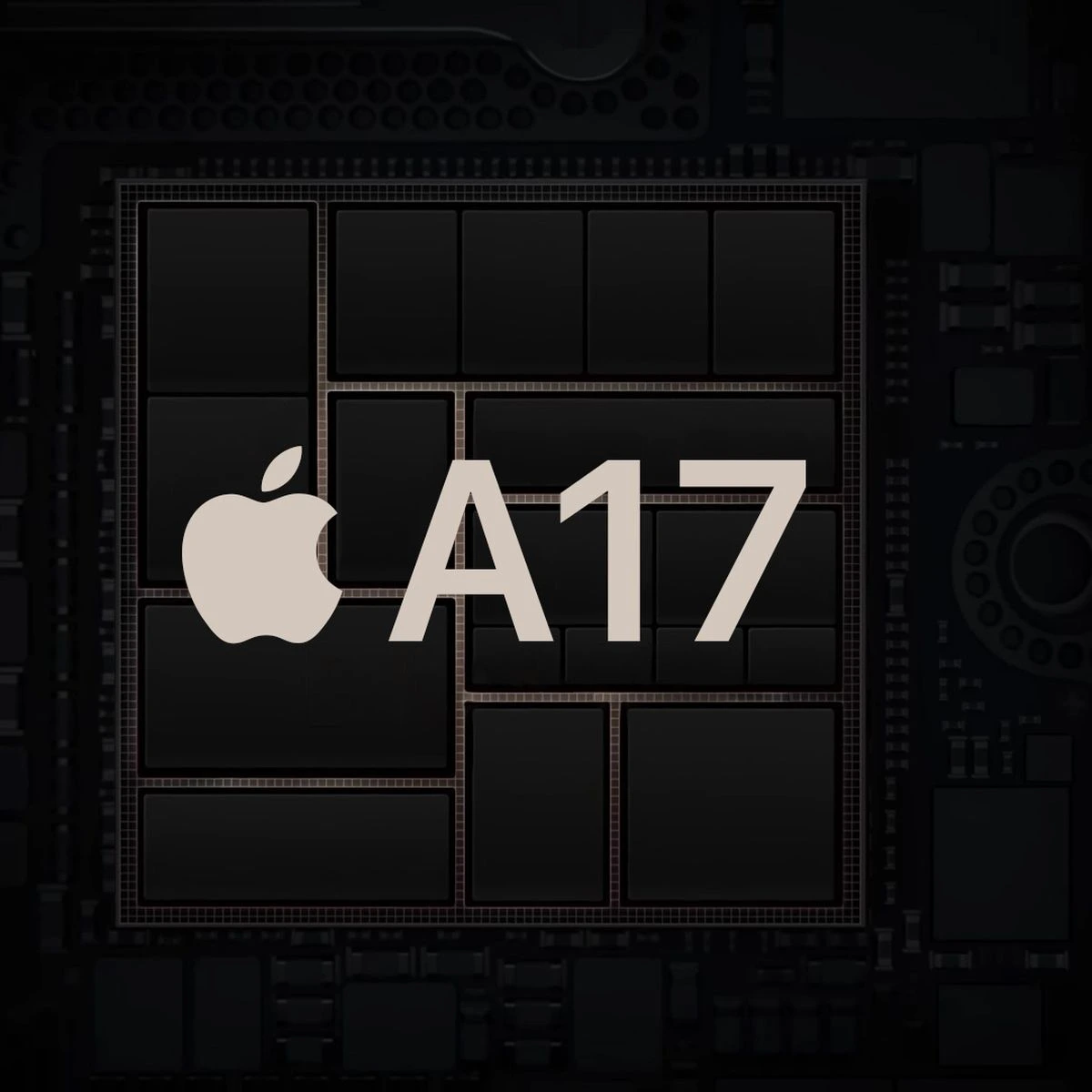
Following their established two-tier strategy, Apple is reserving the A17 Pro Bionic, their fastest new processor, exclusively for the iPhone 15 Pro and Pro Max. Meanwhile, the iPhone 15 and 15 Plus are benefiting from the A16 Bionic’s upgrade, which trickles down from last year’s iPhone 14 Pro lineup to these mainstream devices.
Apple proudly boasts the A17 Pro as the “fastest chip ever seen in any smartphone,” and this claim seems justified based on years of speed tests. Typically, iPhones are at least a year ahead of their Android counterparts in terms of raw processor speed. Apple’s dominance in processor technology enables them to distinguish their products, introduce necessary features, offer long-term iOS software support, and maintain their premium pricing.
The A17 Pro is Apple’s inaugural processor manufactured using TSMC’s 3-nanometer process, a cutting-edge manufacturing technique with smaller features that deliver superior performance and efficiency. While MediaTek had previously highlighted its use of TSMC’s 3nm process in September, their Dimensity mobile processor won’t enter high-volume production until 2024.
Utilizing advanced chip manufacturing technologies is a critical strategy for staying ahead of competitors, as these new methods can accommodate more circuitry elements known as transistors, enabling the integration of more features. The A17 Pro boasts an impressive 19 billion transistors, up from the 16 billion in the A16. To provide some context, the A15 featured 15 billion transistors, the A14 had 11.8 billion, and the A13 included 8.5 billion.
Similar to its predecessor, the A17 Pro sports six CPU cores that serve as the device’s primary processing units. This configuration includes a pair of high-performance cores that are now 10% faster than the previous year, along with four efficiency cores. The efficiency cores handle various tasks on the phone, which don’t always require maximum speed but must always consider the phone’s limited battery capacity. In a straightforward explanation, these efficiency cores offer three times more performance per watt compared to unnamed competitors, as stated by Apple.
Specifically designed for iPhone 15 Pro (or Ultra)
In simpler terms, just like last year when the iPhone 14 Pro had the A16 chip while the regular iPhone 14 used the A15 chip, we’re likely to see a similar pattern this year. The new A17 chip will be reserved exclusively for the iPhone 15 Pro and iPhone 15 Pro Max (or possibly iPhone 15 Ultra if the rumors are accurate), while the standard iPhone 15 will feature the A16 chip used in the iPhone 14 Pro models.
Is this Apple’s strategy for the foreseeable future? It seems likely. Smartphone features and quality have reached a point where there’s not much room for significant improvement, and Apple’s phone chips consistently outperform most Android phones. So, there’s little incentive for Apple to change this approach. It helps them save on production costs and makes a clear distinction between regular and Pro models, which often encourages customers to opt for the pricier iPhone models.
Apple’s first 3nm chip
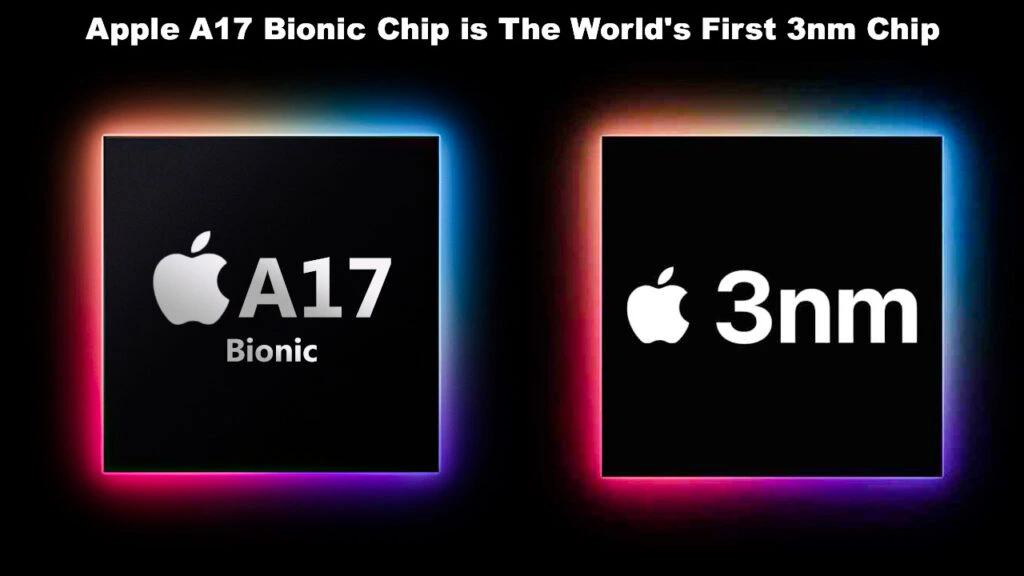
The A14, A15, and A16 chips were all created using a 5nm manufacturing process from TSMC. Over time, this process has improved, resulting in denser chips with better energy efficiency. However, the next significant leap is on the horizon, and it’s almost certain with the A17—the first widely available consumer chip manufactured using TSMC’s advanced 3nm process.
Let me explain why this matters: With the move to 3nm, Apple gains a major advantage in terms of chip density. While the A16 chip contained around 16 billion transistors, we can expect the A17 to pack in well over 20 billion, potentially reaching as high as 24 billion transistors.
Now, here’s the key point about the 3nm process—it offers enhanced power efficiency when compared to a chip of similar speed and capabilities. However, Apple isn’t likely to create a chip with similar speed. There are limitations on the maximum power a chip can draw due to factors like battery size and heat dissipation. So, we can’t expect a massive improvement in battery life solely from the transition to 3nm, especially during intense usage when the chip, display, and radios collectively contribute to power consumption.
However, where we might see some improvement is during standby mode. With the shift to the 3nm process, standby battery life could noticeably improve.
Performance and attributes of the central processing unit (CPU)

ARM introduced its v9 architecture in 2021, and initially, we thought the A16 might be Apple’s first chip to embrace this new architecture. However, it turned out that the A16 supported ARM v8.6 with significant Apple-specific extensions. This year, with a larger transistor budget, it’s highly likely that ARM v9 support will be incorporated.
Now, let’s talk about what advantages the ARM v9 instruction set and architecture bring to the table. Apple is known for designing its own CPU cores, and many of the performance enhancements promised by the v9 architecture are already present in Apple’s designs and their customized ARM extensions. To put it in context, the Snapdragon 8 Gen 1 was one of the initial high-end smartphone CPUs to feature ARM’s Cortex-X2 core with ARM v9 support, and yet Apple’s A15 outperformed it by a significant margin.
You might come across claims that ARM v9 offers a 30 percent boost in performance over ARM v8, but these figures are primarily for ARM’s own core designs and don’t account for the utilization of custom extensions. Apple operates in a league of its own in this regard, so we shouldn’t necessarily expect the A17 to deliver a 30 percent increase in CPU performance.
The new CPU cores in the A17 will likely be faster, but the reasons for this improvement aren’t solely linked to the shift to ARM v9. CPU core performance depends on various factors such as the instruction set, branch prediction, instruction decoding, execution units, cache size and structure, clock speeds, and more.
GPU performance and features
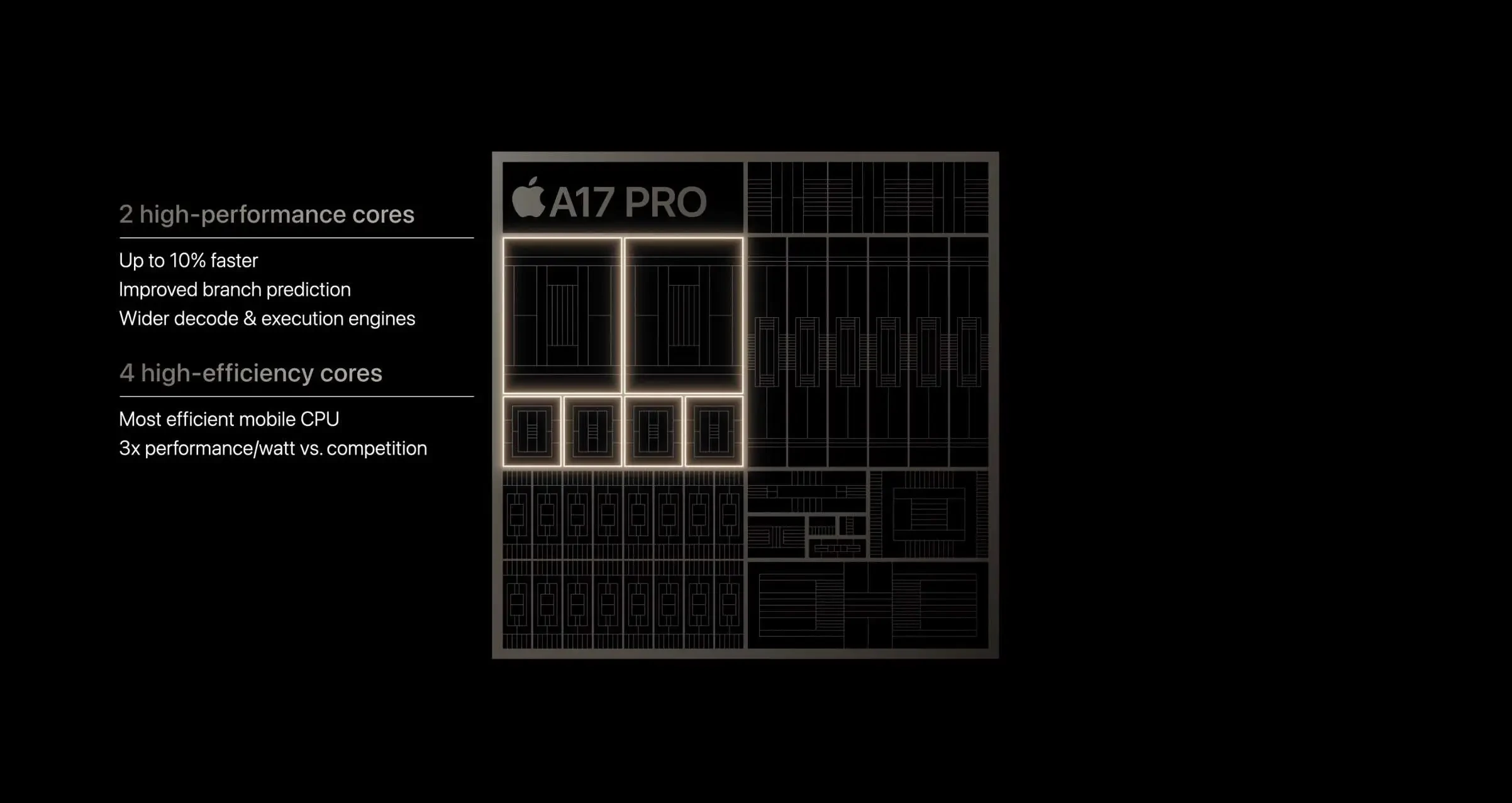
The GPU in the A17 has the potential to be quite intriguing. Historically, Apple has been boosting GPU performance with each new A-series chip, typically by about 20 percent, though it can vary from 15 percent to 30 percent. However, what hasn’t seen significant changes is the overall feature set of the GPU. While it’s getting faster, there have been only minor additions such as variable rasterization rates and SIMD improvements for GPU computing. Unfortunately, Apple lags behind desktop GPUs in crucial features like ray tracing acceleration.
There’s a somewhat uncertain rumor suggesting that the A16 was initially intended to have a major GPU architecture overhaul, but it wasn’t ready in time. Consequently, it ended up with the same GPU as the A15, albeit with improved memory bandwidth for better performance. This speculation is partly supported by the fact that Apple hasn’t updated its Metal feature set tables for developers to include the A16, which is a noteworthy omission.
It seems probable that Apple has a refreshed GPU architecture ready for the A17. While features like ray tracing acceleration may not be essential for iPhones, this GPU design will likely find its way into future M-series Mac processors. The absence of advanced GPU features, like ray tracing acceleration, has put Apple’s Mac processors behind the cutting edge.
Anticipate improved performance in current 3D games and applications that rely on the GPU for computation. When the architecture undergoes changes, the speedup can vary significantly—some tasks see substantial improvements, while others may not experience as much enhancement.
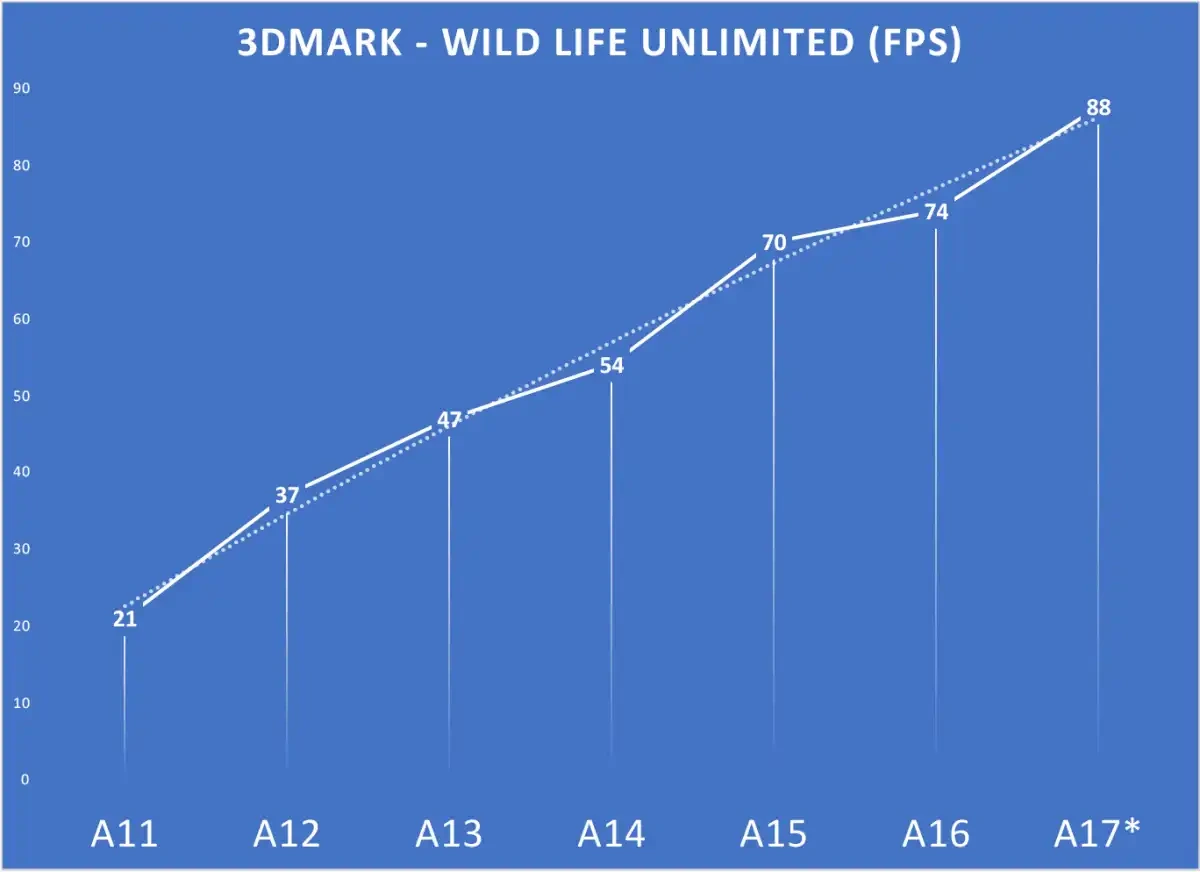
Staying the course with a roughly 20 percent speedup produces a Geekbench 5 GPU compute score of over 18,000. Remember, that benchmark measures the computational performance of the GPU, not its ability to render 3D graphics.
When it comes to 3D graphics, a 20 percent speed boost would mean that the modern 3DMark Wild Life Unlimited test would run at approximately 88 frames per second (fps), compared to the 74 fps achieved with the A16 chip. Currently, the Snapdragon 8 Gen 2 outpaces the A16 in this test and other 3D graphics assessments, but this improvement would put Apple slightly ahead.
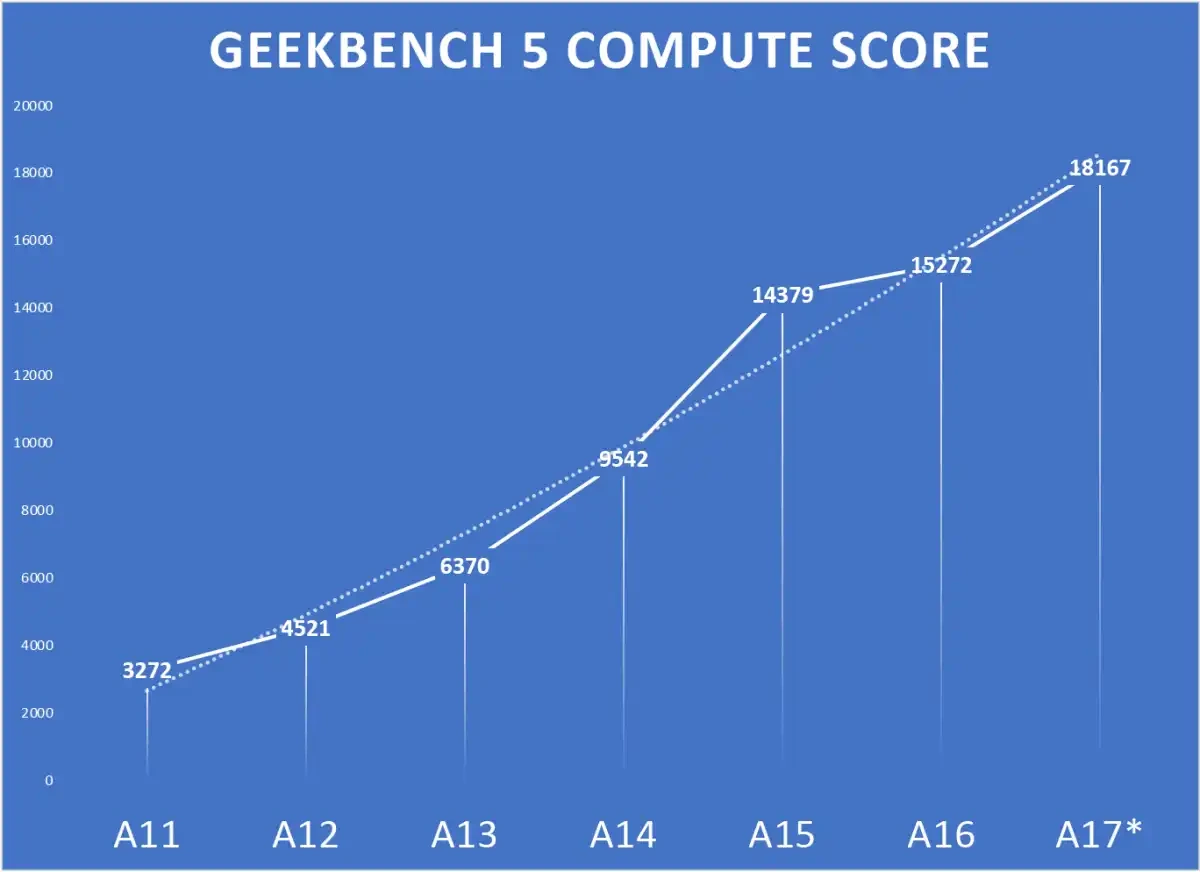
Unlike CPU enhancements, GPU performance tends to show more variability from year to year. The A15 to A16 transition saw modest improvements, primarily due to slight clock speed enhancements and better memory bandwidth. If we see both a new GPU architecture and a significant manufacturing process enhancement this year, the leap in GPU performance could be considerably larger.
Now, let’s briefly touch on the media engine, which is often loosely associated with the GPU. This seems like an opportune moment to express our hopes for hardware acceleration of the AV1 format for encoding and decoding. After all, this format is prevalent in most new-generation PC GPUs. We anticipate that Apple will continue its investments in enhancing the performance and power efficiency of its encoders for formats like H.264, HEVC, and ProRes.
Continued attention to making computers smarter through ML and AI.

Apple is quite involved in using smart computer programs and artificial intelligence. While they might not be pushing as hard as some other companies in the race to create AI systems like ChatGPT, Midjourney, or Stable Diffusion, they’ve been using AI and smart technology in their operating systems and apps for a long time. They keep adding new features, like the ability to pick out text in pictures. Apple dedicates a significant part of their technology to something called the “Neural Engine,” which helps with tasks that use machine learning.
Now, when it comes to the A16 chip, it didn’t look like Apple made many changes to the Neural Engine. It still has 16 cores, and even though it can do 17 trillion operations per second, that’s only 8% faster than the A15’s Neural Engine. This small improvement probably comes from running it at a slightly higher speed, and honestly, we were hoping for more.
But with the 3nm process, they can use a lot more transistors, which means the Neural Engine could get a lot better. It might have more cores, or they might change how the cores work, or even both. I’d be surprised if it doesn’t do more than 20 trillion operations per second. Although, some people argue that measuring performance just by counting how many operations per second it can do might not be the best way to judge it.
Faster LPDDR5x RAM
With the A16, Apple boosted the RAM to LPDDR5 (from LPDDR4x in the A15). Competing top-tier chips like the Snapdragon 8 Gen 2 use LPDDR5x, which delivers about 33 percent more bandwidth and lower memory latency while using the same power.
Having more memory bandwidth is like having a faster highway for data, and it’s great for pretty much everything, especially when it doesn’t use up more energy. The biggest winners from this improvement will be high-end 3D games because they make both the brain (CPU) and the muscle (GPU) of the phone work hard and need a lot of data moved around quickly.
Apple isn’t always the first to adopt new memory standards, but they really care about having lots of memory bandwidth and big storage areas that work quickly. They understand the advantages of moving data around fast, not just processing it faster. I’d say there’s a 50/50 chance that we’ll see LPDDR5x RAM in the A17 chip.
Apple is still using Snapdragon modems for now.
Apple is likely to begin using its own 5G modems from next year, starting with the iPhone SE in the spring and potentially in the iPhone 16 series in the fall.
For the iPhone 15 series, especially the Pro models, Apple is expected to use the Snapdragon X70 modem. Most of the top features of the X70 are similar to the X65 used in the iPhone 14 Pro. However, it has a small built-in AI processor that constantly checks and improves connection quality. This should make connections more stable and efficient, ultimately leading to better real-world speeds and longer battery life.
FAQs
What is the Apple A17 Bionic chip?
The Apple A17 Bionic is Apple’s latest custom-designed system-on-a-chip (SoC) for their mobile devices, known for its performance and efficiency.
What improvements can we expect from the A17 Bionic?
Anticipated improvements include enhanced CPU and GPU performance, potentially exceeding 20 trillion operations per second for the Neural Engine, increased memory bandwidth, and the possibility of Apple’s own 5G modems.
How might the A17 Bionic impact gaming?
The A17’s improvements, including increased memory bandwidth, are expected to benefit high-end 3D gaming, providing smoother and more immersive experiences.
Will the A17 Bionic have AI enhancements?
Yes, the A17 may feature AI improvements, potentially through architectural changes and higher Neural Engine capabilities, which could enhance real-world performance and battery life.
Is Apple switching to its own 5G modems with the A17 Bionic?
Apple is expected to begin using its own 5G modems, possibly starting with the A17 Bionic, which could offer more control and optimization for connectivity in their devices.
When can we expect devices with the A17 Bionic chip to be released?
Devices featuring the A17 Bionic chip are anticipated to be released in the coming year, with potential launches in both the spring and fall.
How does the A17 Bionic compare to its predecessors, like the A16?
While specific details are not confirmed, expectations are that the A17 will surpass the A16 in terms of performance and efficiency due to a more advanced manufacturing process and potential architectural changes.
What role does AI play in the A17 Bionic’s performance?
AI is integral to the A17’s capabilities, especially through the Neural Engine, which handles machine learning tasks. The A17 is likely to enhance AI performance and efficiency.
Final words
The Apple A17 Bionic chip is expected to bring several exciting improvements this year. These enhancements may include a significant leap in CPU and GPU performance, thanks to a more advanced manufacturing process and potential architectural changes. The Neural Engine may also receive a substantial upgrade, possibly exceeding 20 trillion operations per second.
Additionally, increased memory bandwidth is anticipated, benefitting various tasks, especially high-end 3D gaming. Moreover, the use of Apple’s own 5G modems and improvements in AI monitoring for connectivity could further enhance the overall user experience. Overall, the A17 Bionic chip promises to deliver notable advancements, making it a noteworthy addition to Apple’s lineup.







![TablePlus Review [year]: Features, Pricing, Pros & Cons](https://myappleguide.b-cdn.net/wp-content/uploads/2025/07/TablePlus-Review-Features-Pricing-Pros-Cons-150x150.webp)




